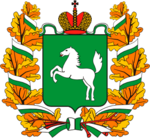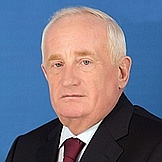Regional flags and emblems


PROFILE
Established 13 August 1944
Capital Tomsk
The Tomsk Region is part of the Siberian Federal District
Area 314,400 sq km
Population 1 039 500 (2025)
Ethnic groups
(2020 national census, %)
Russian – 93,38
Tatar – 1,20
Other – 5,42
Administrative divisions (2024)
Municipal districts –16
City districts – 4
Rural towns – 3
Rural districts – 112
Geography and climate
The Tomsk Region is located in the geographic center of Siberia. It borders on the Krasnoyarsk Territory, and the Kemerovo, Novosibirsk, Omsk, and Tyumen regions, and the Khanty-Mansi Autonomous Area – Yugra. The main river is the Ob with tributaries: the Tom, Chulym, Ket, Tym, Chaya, Parabel and Vasyugan. Mirnoye is the largest lake.
The climate is continental. January temperatures average –21,1°C. July temperatures average 17.2°C. Precipitation averages 26 mm in January and 42 mm in July. The frost-free period lasts from 100 to 105 days. The growing season lasts for 135–140 days in the north, 150 days in the south.
The region has Vasyganskiy State Nature Reserve, 18 regional nature sanctuaries, a Siberian botanical garden at Tomsk State University.
Government
The legislative branch is the Tomsk Region Duma, which is the permanent, representative and only body of legislative authority in the region. Deputies are elected for five years.
The Tomsk Region Duma has 42 deputies elected for five years, with 21 running in single-member constituencies and the other 21 in the single electoral district, where winners are identified in proportion to the number of votes cast for lists of candidates nominated by electoral associations. The current Tomsk Region Duma was elected in September 2021. The term ends in September 2026.
The executive branch in the Tomsk Region is represented by the Governor of the Tomsk Region, the Administration of the region, and other executive agencies of the region. The Administration of the Tomsk Region is the supreme and permanent body of executive authority in the region. The Governor of the Tomsk Region heads the regional Administration.
The Governor of the Tomsk Region is the region’s highest-ranking official who heads the executive branch in the Tomsk Region and determines the structure of executive bodies in the Tomsk Region. The Governor is elected for five years by Russian citizens who permanently reside in the region. The current governor’s term expires in September 2027.
Economy and natural resources
Industrial output accounts for about 40% of the regional GDP. Oil and gas, chemical, petrochemical, engineering, nuclear energy, electricity, timber and food processing are the region’s main industries.
A Rosatom subsidiary, Siberian Chemical Combine, is working on the Proryv (Breakthrough) Project to create new-generation nuclear energy technology. Tomskneftekhim and Siberian Methanol Chemical Company are the largest petrochemical companies in the region.
The region has several large investment projects, such as Farmstandart-Tomskkhimfarm and Virion (Mikrogen subsidiary in Tomsk) to produce new medicines.
Sibkabel, Tomsk Electromechanical Plant, Polyus Scientific and Production Centre, Manotom, EleSi, Mikran, Siam Company, Tomsk Electronic Company are among the leading engineering companies. Tomsk industrial companies provide import substitution products for large Russian corporations including Gazprom, Gazpromneft, Inter RAO, Rosseti and Sibur Holding.
Almost 2,000 construction companies as well as 160 building supply producers are in the construction sector.
The Tomsk Region ranks among the top twenty Russian oil and gas producing regions. Tomskneft is the largest oil company in the region with almost 60% of the extracted oil.
The Tomsk Region ranks third in the Siberian Federal District and seventh in Russia, in terms of wood and timber supply. In addition to large companies such as Tomlesdrev, Ruskitinvest, there are about 100 small and medium businesses in the region. Due to the large investment volume, large wood processing centers have been built up in Tomsk and Asino as well as research centers to determine the prospects for the industry’s sustainable development.
Agriculture accounts for about 4% of the regional GDP. The region’s agro-industrial sector includes dairy and beef farming and fully meets the region’s demands in pork, poultry and potatoes. Siberian Agrarian Group, Mezhenino Poultry Factory, Tomsk Poultry Factory and Tomsk Food Company are the largest regional agricultural companies. Dubrovskoye, Zavarzino Breeding Plant, Nelyubino and Zonal Feed Plant are the main dairy producers.
Culture and tourism
The Tomsk Region’s cultural areas combine remnants of ancient archaeological cultures (Samus, Molchanovo, Kulaika and Ryolka) as well as customs and traditions of the indigenous Siberian peoples (Siberian Tatars, Selkups, Khanty, Evenks and Chulyms), Russian settlers and numerous national diasporas (Polish, German, Estonian and other).
The region’s cultural institutions include regional and municipal museums, professional theatres, a philharmonic hall with one of the best Russian organ halls, galleries and artistic workshops as well as clubs and cultural centers and libraries.
The region has over 700 Russian cultural heritage sites (historical and cultural landmarks), more then half of them has status of federal importance.
Tomsk State University and Tomsk Polytechnic University are part of national valuable cultural heritage.
Wooden architecture is an important part of the image of the Tomsk Region.
Regional tourism is a young and actively growing economic field represented by over 130 sites and 180 hotels of various types capable of accommodating at least 4,000 people in total. There are also farming and hunting grounds, tourist bases, guesthouses, campsites and eco-villages. Travel agencies offer over 70 types of tours, depending on the theme, the sector of the economy or the museum, as well as about 20 types of comprehensive tourist programmes. Tourists will be particularly interested in national culture and holidays, which are key drivers of ethnic and event tourism.


